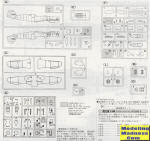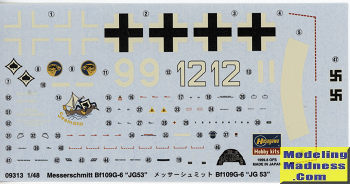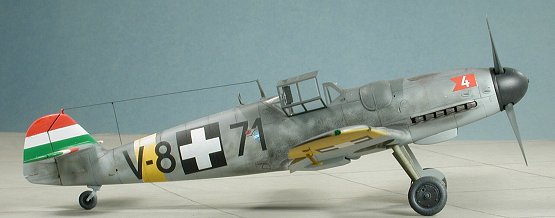
Hasegawa 1/48 Bf-109G-6 'JG53'
| KIT #: | 09313 |
| PRICE: | 2400 yen |
| DECALS: | Two options |
| REVIEWER: | Scott Van Aken |
| NOTES: | 1999 Limited Edition |

| HISTORY |
Jagdgeschwader 53 (JG 53) was a Luftwaffe fighter-wing of World War II. It operated in Western Europe and in the Mediterranean. Jagdgeschwader 53 - or as it was better known, the "Pik As" (Ace of Spades) Geschwader - was one of the oldest German fighter units of World War II with its origins going back to 1937. JG 53 flew the various models of the Messerschmitt Bf 109 throughout World War II.
Here is a brief on its operations in the Med as befits the subject of this boxing. In late 1941, JG 53 moved to bases in Sicily for operations against Malta (though elements also served in the Netherlands from July to November 1941). The III. Gruppe was transferred to North Africa for a short time in December 1941 while the rest of JG 53 was eventually moved to Comiso in Sicily for operations against Malta, which ended in May 1942. In the summer of 1942, II./JG 53 operated from the island of Pantelleria for operations over Malta and as escort missions for attacks on British supply convoys.
In May 1942 after the termination of the German air offensive against the British island fortress of Malta the "Pik As" Geschwader was split up, with its three Gruppen scattered over three theatres of operation. III./JG 53 again saw service in North Africa supporting Rommel's planned advance on Cairo. Stab and II./JG 53 which were left behind on Sicily after the end of the "Malta Blitz" in May for service over the central Mediterranean, and I./JG 53 was moved to the Eastern front, where it was to take part in the German summer offensive in the southern sector aimed at Stalingrad and the Caucasus.
| THE KIT |
 Like
their 109E series, Hasegawa's 109G kits all date from the early 1990s and while
there have been newer toolings from other companies that offer greater detail,
the Hasegawa offerings are still considered by many to be excellent kits. Not
the least due to their ease of construction.
Like
their 109E series, Hasegawa's 109G kits all date from the early 1990s and while
there have been newer toolings from other companies that offer greater detail,
the Hasegawa offerings are still considered by many to be excellent kits. Not
the least due to their ease of construction.
The kits offer a fairly nice cockpit that could benefit from a seat harness. As these kits are based on their F kit, you will need to do a bit of semi-advanced modeling in terms of filling engraved features, cutting a new panel line in each upper wing and removing a bit of material to make the wheel well openings squared off. You'll also need to open holes for the upper wing wheel clearance bumps. Messerschmitt changed the angle of the wheels on the axle which required these to be added for clearance.
The interior is installed from the underside prior to attaching the wings to the fuselage which is nice. The prop has separate blades that are keyed into the spinner backing plate. Also separate is the upper cowling section. Exhaust can be added after painting. A sand filter is optional and used on one of the markings options. Also optional are underwing canon, so if using these, you need to open holes prior to assembling the wings. For the centerline, a drop tank and mount are given.
Flaps, slats and cooler exhaust doors are separate as well. You have a separate windscreen, canopy, and rear quarter section so the canopy can be posed open if you so wish. A DF antenna is provided for the upper fuselage so if using, this is another hole you need to open.
 Instructions
are standard Hasegawa fare with Gunze paint references. You are provided the
standard G-6 instructions with an addendum sheet for the new markings.
Both of the markings options are in RLM 74/75/76 with fairly heavy mottling.
Both also have a while fuselage band. The box art plane was flown by Georg Amon
of 7./JG 53 in June 1943, while the second option was flown by Wilhelm Mink of
4/JG 51 in July 1943. Both options also have a yellow lower cowling. Decals are
nicely printed and need hot water to work properly. These are 'old school'
Hasegawa decals with off-white white areas so you might wish to seek
aftermarket.
Instructions
are standard Hasegawa fare with Gunze paint references. You are provided the
standard G-6 instructions with an addendum sheet for the new markings.
Both of the markings options are in RLM 74/75/76 with fairly heavy mottling.
Both also have a while fuselage band. The box art plane was flown by Georg Amon
of 7./JG 53 in June 1943, while the second option was flown by Wilhelm Mink of
4/JG 51 in July 1943. Both options also have a yellow lower cowling. Decals are
nicely printed and need hot water to work properly. These are 'old school'
Hasegawa decals with off-white white areas so you might wish to seek
aftermarket.
| CONCLUSIONS |
Despite what might seem like an ancient kit to some, these are still very nice kits and are something that many of us have built...a lot. I still have quite a few of these and see no reason to get rid of them just because there are newer kits out there. They can often be found at fairly reasonable prices and are worth building. Here is a photo of one I did some 22 years back. It still holds up well.

July 2021
Copyright ModelingMadness.com. All rights reserved. No reproduction in part or in whole without express permission.
If you would like your product reviewed fairly and fairly quickly, please contact the editor or see other details in the Note to Contributors.